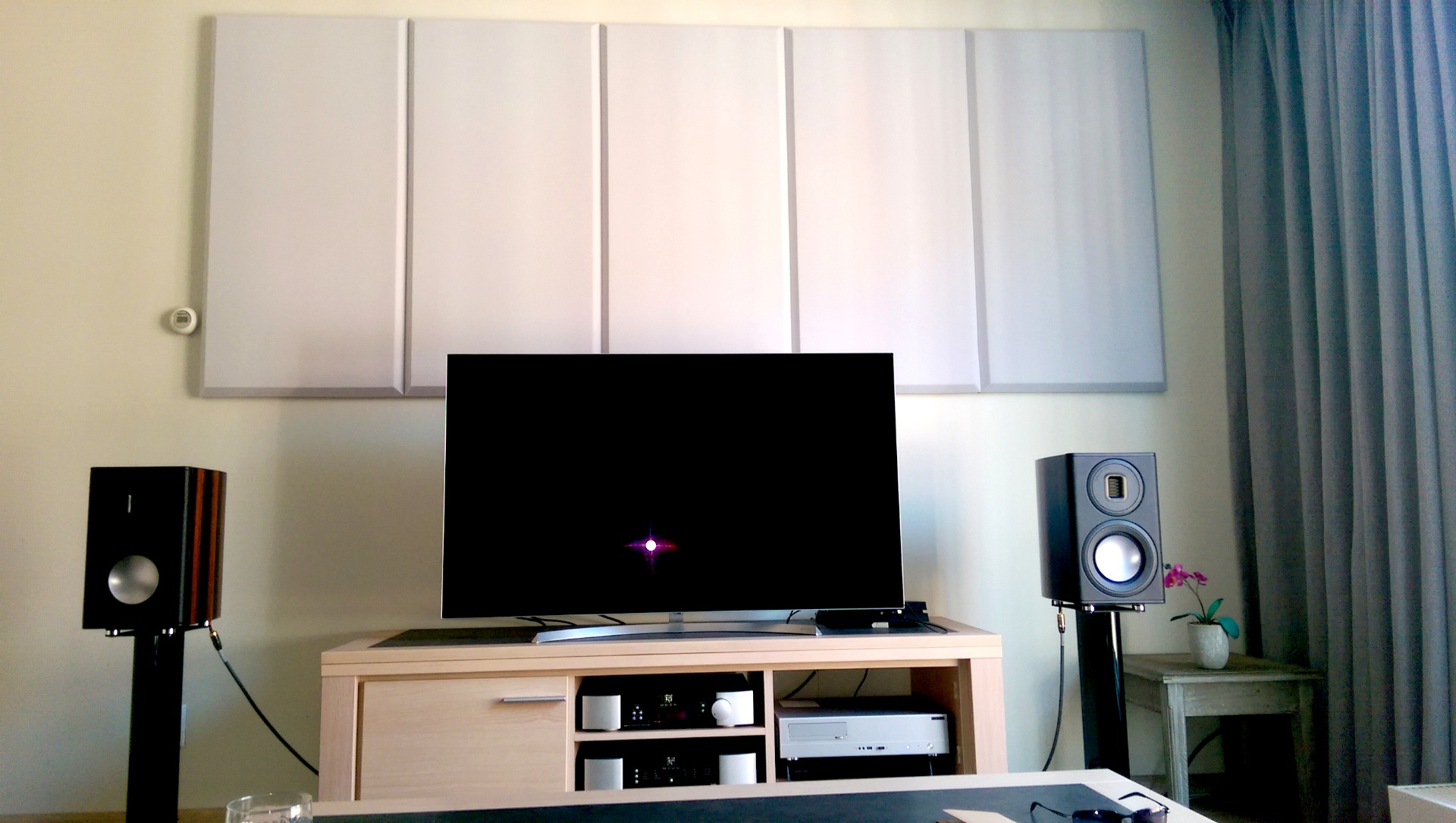Improve the living room acoustics to use it as a HiFi listening room
The UK has a considerable Hi-Fi community. We regularly get the question: "How do I improve the acoustics in my living room which I also use as a Hi-Fi listening room?" On this tips page you will be able to read the answer to this question. We explain what constitutes a solid foundation to improve the acoustics in your living room that simultaneously functions as a listening room.
Most common sound problems
- Flutter echo
The most common problem is reverberation in the middle and high-frequency range. Many know this problem as flutter echo. For those who are less familiar with the term: flutter echo can be recognized by the bright reflections coming from hard surfaces that run parallel to each other such as floor, ceiling and opposing walls. When you clap your hands on different spots in the living room, you can immediately hear whether there is a flutter in your room. Although a certain degree of flutter, or reverberation, in your room is not bad at all, as it allows for a more vivid music experience.
- Standing waves
This noise problem occurs regularly in rectangular living rooms and is a lot more difficult to solve. Not because of the nature of the problem, but because of the measures that are required to solve the problem (installing bass traps for instance). When the music in your room sounds whirring or buzzing, you are probably dealing with standing waves. This is often experienced as a distorted sound image, meaning either too much or too little bass sound. Unlike a small amount of reverberation, any amount of standing waves is negative.
Recognizing problems
Most people have no trouble recognizing or describing the problem, but if you do, here is a nice tip. Listen carefully to several songs or pieces of music that are familiar to you. This way, you can find out whether the singing and bass sounds do not render each other incomprehensible and whether the music does not sound too strident.
Product selection
If all went well, you may already be able to guess which product applies best to your acoustic problem, after listening to the pieces of music. The product must be able to absorb the frequencies that were too prominent in your room while listening, whether flutter (high frequency) or standing waves (low frequency). On our various product pages, you will find graphs of the absorption values. Acoustic problems with prevailing frequencies from ± 750 Hz can be solved by using any product from the "Acoustic Panels" page. In the graphs you can see that almost all products score well in terms of absorption values from that frequency.
A solution in practice
This photo, showing a beautiful Hi-Fi set from Moon, was sent in by a customer who wanted to tackle the issue of poor acoustics in his living / listening room. After purchasing the set, it turned out to be rather disappointing in terms of performance, due to defects in the room acoustics. Both medium and high frequencies did not sound as they should. By mounting Flamex Edge acoustic panels, the medium and high frequency sounded as the should.
In a setup like this, there are two possibilities: installing the panels either behind or in front of the listening position. The difference between these two options is as follows. If the panels are installed behind the listening position, a more direct absorption of the sound is realized, which results in a slightly drier acoustics. One method is not better than the other, it is a matter of individual preference and will depend on the decoration of the room and the desired effect. First, place the panels in the room while being detached and listen to music with the placement before finally fixating them.
Photo and reaction of our customer
"I finally found the source of the acoustic problem and the panels have now been assembled. At least the reverberation is gone, the only thing that still bothers me a bit is an excess of bass, but for the time being I solved this by dampening the bass ports."
To give you an idea of the living and listening room in question:
- Living room floor area 18 m²
- High pile carpet
- Heavy curtains
- Leather sofa
- 5 Flamex Edge panels with a thickness of 50 mm
Additional tips
If you continue to detect too much reverberation, the opposite wall or ceiling can also be equipped with absorption panels. Do not mount too many acoustic panels right away. For example, first mount four to six panels and do some sound checks, so that it doesn't become too dry. You can always purchase some more panels if needed.
Correct positioning of the speakers can also improve the sound. When possible, place the speakers at least 50 to 70 cm from the wall and from the corner(s). This benefits the reproduction of low frequencies. Turning the speakers in- or outwards can also provide better reproduction of sound.
Make sure that the center of your speaker is approximately located at ear level and turn the speakers inwards to create a triangle between the two speakers and the listening position. Keep the following ratio in mind: if the speakers are three meters apart from each other, the distance to the listening position of each speaker must also be three meters. The speakers are fine in this example in terms of distance, but turning them slightly inwards reduces standing waves and improves detail in reproduction of stereo sound.
Questions? 
Do you have any questions about this topic? Please contact us, we will be happy to answer your questions as soon as possible.

 Sound Insulation
Sound Insulation  Soundproofing
Soundproofing  Vibration Isolation
Vibration Isolation  Silent Ventilation
Silent Ventilation  Accessories
Accessories  Thermal & Acoustic Insulation
Thermal & Acoustic Insulation 
